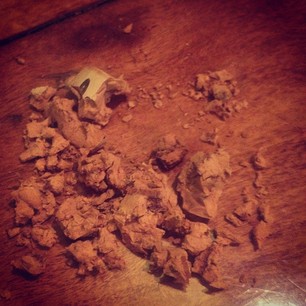Last night, my lovely bride and I drove to the Hunter Valley and arrived in time for dinner at the Blue Thai restaurant which we really enjoy. The food is great and the crowd is certainly interesting and entertaining as the restaurant abuts a trailer and camping park. It is a BYO restaurant, which is a concept I always like! There were several cartons of box wine sitting on other tables (why come to the Hunter Valley and get box wine?!?!) and I expect there were not many other bottles over $10 in the restaurant that night.
Yet, Thai food has such tremendous flavors and deserves to be paired with good wine. We usually bring a Gewurztraminer, Semillon or Riesling. Tonight we brought along a bottle of the 1995 Penfolds Adelaide Hills Semillon Trial Bin. I have four bottles of this, but had not had much interest in trying one as it was an inexpensive wine I purchased back in 1997 in Melbourne. It had not been cared for well either in that it made a trip across the ocean to the US in 1998 when I moved back there, and then a trip back home in 2000 when I moved here permanently. Fortunately, most of the wines that made the journey over and back did not suffer much (the better ones were stored in Styrofoam cases) , but some of the cheaper ones were affected.
Recently, I have come to realize that the 1995 Adelaide Hills Trial Bin was one of the wines that was an experiment as a possibility for Penfolds White Grange (according the the public, not Penfolds) which ultimately resulted in the Yatarnna Bin 144 Chardonnay. Plus some of the wine auction houses I was talking with expressed interest in selling this wine at auction and that peaked my curiosity. I decided it was worth trying a bottle to see if it was still good. After all, it was selling for between $25 – $30 per bottle on the secondary market.
 |
| Crumbled cork |
Halliday reviewed this wine a long time ago and said it was drinkable until about 2003 and here I am thinking about trying it almost a decade after that. Yet, I have had many aged Semillons that have really stood the test of time. However the bottle I opened last night, had not! It was unfortunately corked. I used the standard cork screw from the restaurant, but the cork just crumbled. I then drove home to get my Ah So cork screw. The Ah So cork screw is about the only way to get old cork out of an old bottle. It is designed to be able to get old and soggy corks out of the bottle, and I may have had some luck had I started with this, but the cork was so soggy and cushy that I could not get a good grip on it. It was the first time ever that I was not able to remove a cork with the Ah So, and had to push it into the bottle.
I was still hopeful because the wine had a beautiful golden color to it, and their was no obvious fault when visualizing the wine. However, it had lost much of its flavor and had a metallic taste to it. It tasted like someone had squeezed a melon onto a piece of sheet metal and licked it. (I am imagining this is what it would have tasted like – I have not actually done this!) You could tell this was a fine wine in its time, but had oxidized too much. I still managed a few sips with dinner to try to figure out what it would have been like without the fault, but we left 2/3rds of the bottle and mostly had water with dinner.
I am hopeful that the remaining three bottles of this wine may have traveled better than this one did. Cork variability can be quite large. Recently about two weeks apart, I had two bottles of the 2003 Blueberry Hills Pinot Noir and the second one was significantly better than the first one (as described in post). Since both Pinot Noirs had been stored properly and in exactly the same manner, the difference could only be attributable to the difference in cork structure. Therefore, I will try each bottle of the 1995 Penfolds Adelaide hills Semillon Trial Bin and hopefully one or two of the remaining three bottles will be real gems!














